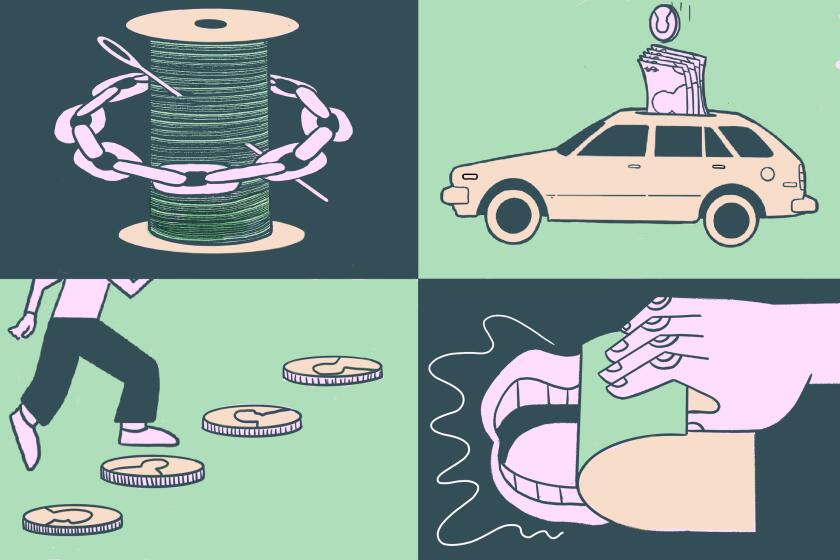Don’t have a 401(k) through work? Californians have CalSavers and other options

- Share via
Years in the making, California’s CalSavers retirement savings program is available now to hundreds of thousands of workers whose employers don’t offer pensions or 401(k) plans.
The program is the state’s response to a looming threat to its aging population: Millions of California workers, especially those in lower-wage jobs, have stashed away far too little money for their retirement. State Treasurer Fiona Ma warns on her office’s website that more than half of workers age 25 to 44 have projected retirement incomes of less than twice the federal poverty level. That translates to an income of $27,180 for a person living alone or $36,620 for a couple.
“Among households age 55 and older, nearly one-third have no retirement savings or pension assets,” Ma wrote, citing a 2015 report by the U.S. Government Accountability Office.
Although anyone can set up an individual retirement account, which offers some important tax breaks, studies show that people are far more likely to set money aside for retirement if they have a savings plan at work, especially if their employer kicks in some matching dollars. And according to a 2019 study by the UC Berkeley Labor Center, more than 60% of private sector workers in this state who were 25 to 64 years old had no company-supplied plan to build savings for retirement by deferring some income (as in a pension) or redirecting part of their paychecks into investments (as in a 401(k) plan).
Hence the CalSavers Trust Retirement Savings Act, which was signed into law in 2016. The act gives employers with five or more workers a choice: Either offer a pension, 401(k) or other qualified retirement savings plan, or enroll their workers in CalSavers. The deadlines were Sept. 30, 2020, for companies with more than 100 employees and June 30, 2021, for companies with 51 to 100 employees; companies with five to 50 employees must comply by June 30, 2022.
Close to 400 companies that faced the 2020 deadline, including 164 in Los Angeles County, have yet to comply, and this month the state is starting to penalize them. Here’s an outline of the CalSavers program and some of the alternatives employers have to meet the state’s mandate.
Totally Worth It
Be your money's boss! Learn how to make a budget and take control of your finances with this eight-week newsletter course.
You may occasionally receive promotional content from the Los Angeles Times.
What is CalSavers?
Launched formally in July 2019, CalSavers seeks to help an estimated 7.5 million workers with no employer-sponsored retirement plan by sweeping them automatically into an individual retirement account overseen by the state.
Katie Selenski, CalSavers’ executive director, said employers cited three main reasons for not offering a retirement plan: the fees charged by plan administrators, the paperwork involved, and the threat of being held liable for not acting in their employees’ best financial interests. “We address all three,” Selenski said — employers pay no fees to CalSavers, which manages much of the paperwork and takes on the liability as the plan sponsor.
Private employers (including nonprofits) that employ five or more people in California without offering them a qualifying retirement plan are required to sign up with CalSavers and submit a list of workers in this state. CalSavers then enrolls all of those workers into the program, creating IRAs that they can take with them no matter how many times they change jobs. Workers have 30 days to opt out; if they do, they can always enroll later.
Workers whose employers are not participating and self-employed Californians can also sign up with the program directly; 1,451 of them have done so thus far, Selenski said. To be eligible, employees have to be at least 18 years old, work in California and have a Social Security or taxpayer identification number.
If your claim is denied, you have a right to appeal and ask your health insurer to take another look.
How does the program work?
If you decide to participate, your employer will deduct a portion of your pay and send it to CalSavers, which invests it into one or more funds managed by State Street Global Advisors and Newton Investment Management. The default contribution is 5% in the first year, rising to 8% in the fourth, but you can adjust that up or down. The most you can contribute each year is $6,000 until age 50, at which point it rises to $7,000.
You can choose from among five types of IRAs with different investment strategies. By default, your money is placed into a low-interest money market fund for the first 30 days, then moved into a “target date” fund that shifts your holdings into less risky investments as your near retirement age.
The other options are a bond “index” fund, which is a low-fee fund that mirrors the performance of a broad range of corporate and government bonds; two different equity index funds that track a range of either U.S. or international stocks; and a “sustainable” fund that invests in companies that meet certain environmental, social and governance criteria. You can split your contributions among multiple different funds or put them all into a single fund.
Noteworthy features of the program include:
- The accounts are all Roth IRAs, which means you’ll still have to pay income tax upfront on the money you contribute, but you won’t pay taxes on the account’s earnings or the money you withdraw if you retire or become disabled. Roth IRAs also allow you to take out money that you contributed, but if you withdraw money the account earned before the account is five years old and you’ve turned 59½, you may have to pay taxes on it and a 10% penalty. By contrast, the money you contribute to a traditional IRA is not subject to income taxes, but you’ll owe taxes (and, potentially, early withdrawal penalties) on any money you take out. Contributing to either kind of IRA can yield a big tax break for low- and moderate-income Californians. If your household income is below $34,000 for a single person (or $51,000 for a head of household, or $68,000 for a married couple), you’ll qualify for a federal retirement savings contributions credit of 10% to 50% of the amount you put into your IRA.
- Because of the restrictions placed by federal tax law, the program does not allow your employer to match your contributions.
For the record:
4:43 p.m. Jan. 21, 2022An earlier version of the story stated that CalSavers holds the first $1,000 of a worker’s contributions in a money market fund to guard against risk. That policy is no longer in effect.
New workplace laws taking effect in January strengthening employees’ health, safety and wage protections and ban corporate muzzling of discrimination victims. But many more mandates tagged “job killers” were stopped from becoming law.
Who is participating?
The number of workers with accounts in CalSavers has grown rapidly since its launch as more employers have signed on. And, according to Selenski, the participation rate has been a consistent 70% at the companies that have rolled out CalSavers IRAs. That’s an encouraging number, she said, considering that the median income of those workers is estimated to be less than $30,000. Roughly half of the money contributed has come from employees at service-industry companies, such as restaurants, hotels and retailers.
Still, Ma’s office reports that fewer than 220,000 people were enrolled as of December 2021; according to CalSavers, only 2% of the nearly 290,000 employers covered by the state mandate are fully on board, and only 8% have at least started the sign-up process. About 20% have been exempted because they have a qualifying retirement program, leaving more than 70% of the covered employers “nonresponsive” — that is, noncompliant.
The vast majority of that latter group is small employers that don’t have to comply until June 30. But the Franchise Tax Board is starting to assess penalties of $250 per eligible worker on companies with more than 100 employees; that penalty will triple for companies that do not comply within 90 days.
Meanwhile, employees in the program are slowly but steadily increasing their retirement savings, with the average amount per person growing steadily over the last year to just under $800 in December. Granted, that’s a relatively low number, but that’s true in part because employees haven’t been enrolled very long. The average contribution of about $150 per month also reflects the modest annual incomes of the typical worker in the program.
Selenski said that 35% of the IRAs set up by CalSavers include contributions from more than one employer. “Either these are people who are working multiple jobs, or it reflects mobility in the labor market,” she said.
People are leaving their jobs in droves in a pandemic trend now known as the Great Resignation. But what if you can’t quit? This guide’s for you.
What are the drawbacks?
It’s hard to argue that people shouldn’t set aside money for retirement. Social Security benefits alone aren’t enough to provide for a comfortable living in a high-cost state like California, and if your career is in a lower-paying industry, they may not even be enough to keep you out of poverty. According to the Center on Budget and Policy Priorities, nearly 10% of elderly Social Security recipients in 2018, or 1.4 million people, had incomes below the federal poverty level.
And the earlier you start saving, the more your savings will grow over time. But setting aside a portion of your income means you have less on hand to cover today’s expenses, and for low-wage workers, that can be a challenge.
In a 2018 study published in the Journal of Retirement, three economists from Illinois State University and the University of Kentucky argued that workers who owed money on their credit cards, cars or college loans would be better advised to pay off their debts than to invest in a CalSavers IRA if the interest rate on their debts was higher than the expected return on their IRA.
But the study assumes that workers blindly enroll and remain in CalSavers, rather than choosing how much to contribute (they can put in as little as 1% of their paycheck) and then not withdrawing their contributions when in a pinch. The program opted for Roth IRAs, Selenski said, precisely because they give enrollees penalty-free access to the money they put into their accounts.
“Our opt-out rate is just under 30%, which demonstrates that some individuals are making the decision to not participate, and that could be for a variety of reasons, including cash flow needs,” she said in an email.
Other critics argue that CalSavers’ expenses are too high, eating into the returns on workers’ IRAs.
The fee for CalSavers’ target-age funds is 0.89%, or $8.90 per $1,000 invested. The fees assessed on similar funds by Vanguard, a low-cost investment house, are about .15%, or $1.50 per $1,000. Fees are a significant concern for investors because their cost compounds over time as the value of your investment grows.
The program has also taken flak online because of its reliance on IRAs instead of 401(k) plans, which would allow bigger worker contributions as well as matching contributions from employers. But requiring employers to offer 401(k)s would run afoul of the federal Employee Retirement Income Security Act of 1974, which preempts state laws that affect the benefits offered by employers. (CalSavers itself was challenged as a violation of ERISA, but the U.S. 9th Circuit Court of Appeals ruled in May 2021 that it was a state program, not an employer-provided benefit.)
By buying the naming rights to the arena formerly known as Staples Center, Crypto.com shone a national spotlight on the niche field of cryptocurrencies. Here is a guide to the world of bitcoin, digital wallets, smart contracts and other key pieces of the crypto puzzle.
Are there alternatives?
There are countless investment options out there for workers who want to start an IRA on their own, many of them with lower fees than CalSavers’. So why don’t more people set up IRAs?
One issue for many is a shortage of disposable income. Another is fear. “People don’t want to make a bad or stupid decision about their money,” said Laurie Rowley, chief executive of Icon Savings Plan, which helps companies set up IRAs for their workers.
“The bottom line is it’s not happening,” Selenski said. “People are not going to sign up for these accounts on their own.”
And yet small businesses aren’t wild about government-run retirement plans. A Pew Charitable Trusts survey of 1,600 small business owners in 2016 found wide interest in retirement benefits, but more than half opposed having state government operate their plan. At the same time, at least half said offering a retirement savings plan was too costly and burdensome, and that their employees weren’t interested in it.
State law no longer allows employers to stay on the sidelines, however. So if they don’t like the idea of signing up for CalSavers, they have at least four alternatives:
- Sponsoring a pension, 401(k) or similar retirement savings plan. These can be costly and time-consuming, but employers can offload much of the work to one of the many investment houses, banks and specialized vendors that serve as plan administrators.
- If they have 100 or fewer employees, offering a SIMPLE IRA plan. These plans carry few of the liability worries that pensions and 401(k) plans do. Notably, employers have to contribute 2% to 3% of a worker’s pay to that worker’s SIMPLE IRA. A wide array of investment houses, banks and vendors are available to set up and administer such plans for a fee.
- Offering a simplified employee pension (SEP), which is an IRA with a twist: Employers, not workers, make all the contributions to the accounts. Similar to SIMPLE IRA plans, the employer has to contribute at the same rate to all employees’ SEP IRAs, but the contribution limits are considerably higher — up to 25% of a worker’s pay, to a maximum of $61,000 in 2022. These plans are also available through banks and investment firms.
- Offering a payroll deduction IRA with automatic enrollment for workers, as CalSavers does. Icon is one of a number of specialized companies and investment firms that can set up one of these plans for a fee.
The mandate on employers has led more of them to create retirement savings plans outside of CalSavers, financial industry executives say. That’s consistent with the state’s goal in setting up CalSavers, which was to get more workers into some kind of retirement savings plan, Selenski said. “We’re agnostic about that,” she added. “We’re mission driven to get people access to a retirement program.”
Here are some ideas for cutting back or cutting entirely.
More to Read
Inside the business of entertainment
The Wide Shot brings you news, analysis and insights on everything from streaming wars to production — and what it all means for the future.
You may occasionally receive promotional content from the Los Angeles Times.
















